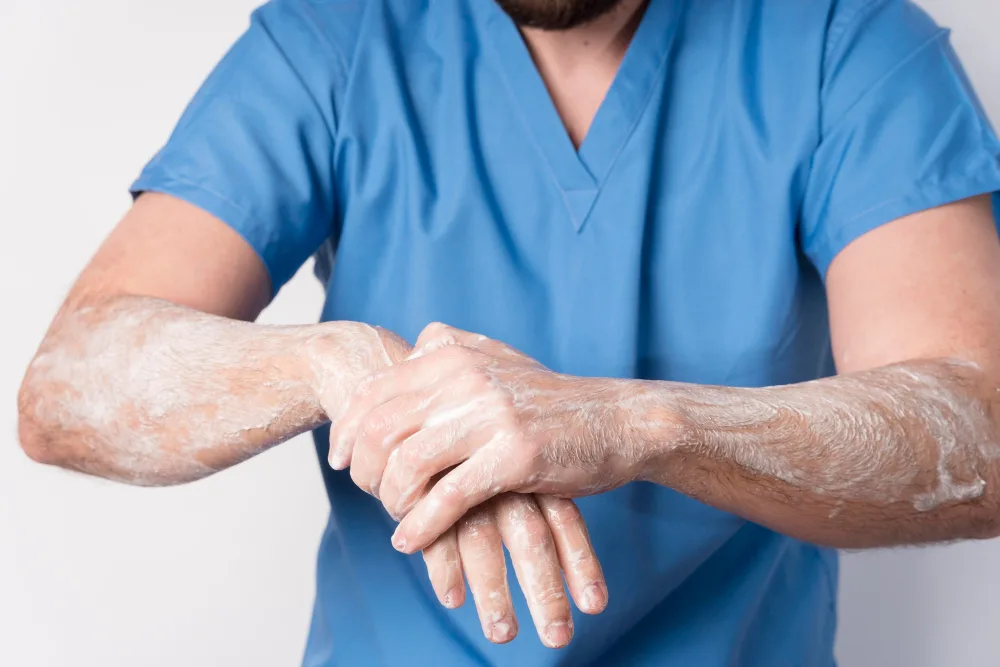What Are the 5 Types of Psoriatic Arthritis?
Category: Orthopedics
Psoriatic arthritis (PsA) is an autoimmune condition that causes joint inflammation in people with psoriasis, a skin disorder characterized by red, scaly patches. PsA can affect different joints and present in various ways, leading to pain, stiffness, swelling, and reduced mobility. Understanding the types of psoriatic arthritis helps in early diagnosis and proper arthritis treatment.
At Lokmanya Hospitals, patients receive specialized care from experienced arthritis specialists in Pune, who provide comprehensive evaluation, advanced diagnostics, and personalized treatment plans. Early intervention and expert management help prevent joint damage and improve the quality of life for PsA patients.
The 5 Types of Psoriatic Arthritis
Psoriatic arthritis (PsA) is a chronic autoimmune condition that affects the joints and skin, often in individuals with psoriasis. Understanding the different types of PsA is essential for accurate diagnosis and personalized treatment. Here’s a detailed explanation of each type:
1. Symmetric Psoriatic Arthritis
Symmetric PsA affects the same joints on both sides of the body, such as both hands, wrists, or knees. This form closely resembles rheumatoid arthritis, with noticeable swelling, pain, and stiffness in the affected joints. Because it impacts multiple joints symmetrically, patients may experience challenges in performing daily activities, such as gripping objects, walking, or bending. Early intervention is crucial to reduce inflammation and prevent long-term joint damage.
2. Asymmetric Psoriatic Arthritis
Asymmetric PsA occurs when only one or a few joints are affected, often on different sides of the body. The inflammation in these joints can range from mild to moderate and may involve small joints like fingers and toes or larger joints such as knees and elbows. Unlike symmetric PsA, the involvement is uneven, which can make it more difficult to recognize initially. Targeted treatment is often necessary to manage pain and prevent joint deterioration in affected areas.
3. Distal Interphalangeal (DIP) Predominant Psoriatic Arthritis
This type primarily affects the small joints at the tips of the fingers and toes, known as distal interphalangeal joints. A hallmark feature of DIP PsA is the presence of nail abnormalities, including pitting, discoloration, ridging, or separation from the nail bed. These nail changes often accompany joint pain and swelling, making it an important diagnostic clue. Early management is vital to preserve fine motor skills and prevent deformities in the fingers and toes.
4. Spondylitis (Axial) Psoriatic Arthritis
Spondylitis, or axial PsA, predominantly affects the spine and sacroiliac joints, leading to chronic back pain, stiffness, and reduced flexibility. Over time, this can affect posture and limit spinal mobility, impacting daily activities such as bending, twisting, or lifting. In addition to standard joint treatments, physical therapy and targeted medications may be recommended to maintain spinal flexibility and manage pain.
5. Arthritis Mutilans
Arthritis mutilans is a rare but severe form of psoriatic arthritis that causes significant joint destruction. The condition leads to bone erosion and shortening of the fingers or toes, resulting in deformities and functional limitations. Due to its aggressive nature, immediate medical intervention is essential to prevent permanent joint damage. Treatment typically involves a combination of medications, supportive therapies, and sometimes surgical procedures to restore joint function.
Understanding these types of psoriatic arthritis allows specialists to tailor treatment plans effectively, reduce inflammation, prevent joint damage, and improve the patient’s overall quality of life. Early diagnosis and ongoing management are key to minimizing the impact of the disease.
Symptoms of Psoriatic Arthritis
1. Joint Pain, Swelling, and Tenderness:
Psoriatic arthritis often causes inflammation in the joints, leading to persistent pain, swelling, and tenderness. Commonly affected joints include fingers, toes, knees, and wrists, making everyday movements uncomfortable.
2. Morning Stiffness and Reduced Mobility:
Many patients experience stiffness in the joints, particularly in the morning or after periods of inactivity. This stiffness can limit the range of motion and make simple tasks, like bending or walking, more challenging.
3. Nail Changes Including Pitting and Discoloration:
Nail abnormalities are a distinctive sign of psoriatic arthritis. These can include pitting (small depressions on the nail surface), discoloration, ridges, or separation of the nail from the nail bed, often indicating underlying joint inflammation.
4. Fatigue and Reduced Energy:
Chronic inflammation in psoriatic arthritis can lead to persistent fatigue, leaving patients with lower energy levels. This can affect daily activities, work performance, and overall quality of life.
5. Severe Cases – Joint Deformities and Bone Erosion:
If left untreated, psoriatic arthritis can cause permanent joint deformities and bone erosion. This results in significant functional limitations and may require aggressive medical intervention to prevent long-term disability.
Why Choose Lokmanya Hospitals for Psoriatic Arthritis Treatment?
Lokmanya Hospitals is recognized as a leading center for psoriatic arthritis treatment in Pune, offering comprehensive care under one roof. The hospital’s team of arthritis specialists provides advanced diagnostics, including blood tests, imaging, and nail assessments, to identify the specific type of PsA.
With a multidisciplinary approach, cutting-edge technology, personalized treatment plans, and ongoing rehabilitation, Lokmanya Hospitals ensures effective symptom management, improved mobility, and long-term joint protection. Patients receive continuous support and guidance, helping them maintain an active and comfortable lifestyle.
Conclusion
Psoriatic arthritis can affect joints in various ways, from mild stiffness to severe deformities, making early recognition and type-specific treatment essential to prevent joint damage and maintain mobility. Timely management also helps reduce pain, fatigue, and functional limitations, improving overall quality of life.
At Lokmanya Hospitals, experienced specialists provide expert evaluation, advanced diagnostics, and personalized care for all types of psoriatic arthritis. Through a holistic approach that combines medical treatment, rehabilitation, and lifestyle guidance, patients receive effective symptom management and support to lead an active, fulfilling life.
FAQs
1. What is psoriatic arthritis?
Psoriatic arthritis is an autoimmune condition that causes joint inflammation in people with psoriasis.
2. How many types of psoriatic arthritis are there?
There are five main types: symmetric, asymmetric, distal interphalangeal predominant, spondylitis (axial), and arthritis mutilans.
3. Can psoriatic arthritis affect nails?
Yes, nail pitting, discoloration, and separation are common in PsA.
4. What are common symptoms of psoriatic arthritis?
Joint pain, swelling, stiffness, reduced mobility, fatigue, and nail changes are common symptoms.
5. Can psoriatic arthritis be cured?
There is no permanent cure, but early treatment can manage symptoms, prevent joint damage, and improve quality of life.
6. How is psoriatic arthritis diagnosed?
Diagnosis involves medical history, physical examination, blood tests, imaging, and sometimes nail assessment.
7. What treatments are available for psoriatic arthritis?
Medications (NSAIDs, DMARDs, biologics), physiotherapy, lifestyle management, and in severe cases, surgery.
8. Why choose Lokmanya Hospitals for PsA treatment?
They provide expert evaluation, advanced diagnostics, personalized treatment, and continuous support for long-term joint health.
Previous blog







